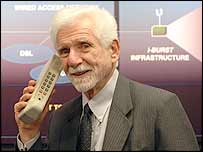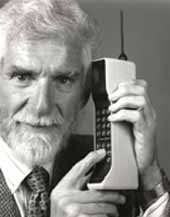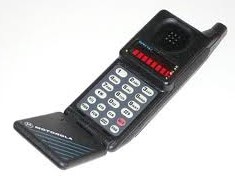The Evolution and Progression of Cell Phones
Cell phones have come a very long way in a relatively short time. The number of people using mobile devices, the capability of phones, and the level of impact that they have on society itself has increased exponentially over a mere handful of decades.
Let’s take a quick journey from Then to Now, to get a big picture view on the growth of our little communication companions.
0G: Zero Generation
Even those of us with children and grandchildren can barely recall the olden days in which the vast majority of phones came with at least two wires (sometimes in an inexplicable curly-fry form), and numbers were entered using a peculiar circular dial thingy. The primitive savagery of those times is best left to the obscuring fog of history, but the truth is that mobile phones have been around much longer than most of us realize.
In fact, “ship-to-shore” radio phones were regularly used (at exorbitant cost) in the 1930s, and the mobile radio phone saw extensive use in World War II. But none of these “Zero G” technologies were truly ‘mobile,’ let alone ‘cellular,’ as they required the transmitter to be adjacent to the handset.
1G: The 1980s
The 1980s were all about analog “car phones.” And when I say “all about,” I mean that almost nobody had one, other than Michael Douglas in Wall Street.
 Actually, the first experimental cell phone made a call in 1973; Motorola’s Martin Cooper called rival Joel S. Engel of Bell Labs, setting a clear trend of one-upmanship that would characterize cell phone owners forevermore. However, the first cellular networks weren’t up and running for another few years. It started with Chicago, which boasted 1,300 customers by 1978 and was soon followed by Japan and some Scandinavian countries which quickly implemented far more widespread 1G cellular networks. Some things never change.
Actually, the first experimental cell phone made a call in 1973; Motorola’s Martin Cooper called rival Joel S. Engel of Bell Labs, setting a clear trend of one-upmanship that would characterize cell phone owners forevermore. However, the first cellular networks weren’t up and running for another few years. It started with Chicago, which boasted 1,300 customers by 1978 and was soon followed by Japan and some Scandinavian countries which quickly implemented far more widespread 1G cellular networks. Some things never change.
 A spiffy 2lb Motorola DynaTAC would set you back about $4,000 for the handset, and about $95 for 100 minutes of talk time each month (and that’s in 1983 dollars, which equates to around $10,000 and $250/month respectively, by today’s standards). In the small radii served by any one of the nation’s 900 or so cellular towers, you and up to 22 other people could enjoy simultaneous mobile calling.
A spiffy 2lb Motorola DynaTAC would set you back about $4,000 for the handset, and about $95 for 100 minutes of talk time each month (and that’s in 1983 dollars, which equates to around $10,000 and $250/month respectively, by today’s standards). In the small radii served by any one of the nation’s 900 or so cellular towers, you and up to 22 other people could enjoy simultaneous mobile calling.
2G: The 1990’s
Digital networks, text messaging, and truly portable handsets all became a reality in the 1990s. Again, Finland and Japan lead the way.
Despite the cost (and bulk) of the first generation of cell phones, the US already had 5 million subscribers by 1990; nearly half of the world’s total.
Scandinavia still had the technological edge however and in 1991 the first 2G network, named Radiolinja, was launched in Finland.
2G not only provided all-digital encrypted calling, it also made data transmission possible and before long, people were sending each other SMS text messages first in the UK in 1992, from a computer to a mobile phone, and a year later from phone to phone in Finland.
Another big change began to take place throughout the decade, in the form of increasing interest in pre-paid calling. Generally utilizing previous-generation technology and catering to less-affluent customers, it proved to be far more of a social revolution than a technological one.
 The
The  phones of the 1990s developed much more quickly than in the previous decade. While Motorola’s portable and futuristic MicroTAC flip-phone design began the decade with a bang, it still came with a price tag of several thousand dollars for a phone with a single-line LED display. By comparison, the reigning king of 1992-1994 was the Nokia 1011, a ‘bar phone’ weighing just over a pound and sporting a lovely LCD screen. By the end of the decade, Nokia had already moved on to phones with browsers.
phones of the 1990s developed much more quickly than in the previous decade. While Motorola’s portable and futuristic MicroTAC flip-phone design began the decade with a bang, it still came with a price tag of several thousand dollars for a phone with a single-line LED display. By comparison, the reigning king of 1992-1994 was the Nokia 1011, a ‘bar phone’ weighing just over a pound and sporting a lovely LCD screen. By the end of the decade, Nokia had already moved on to phones with browsers.
3G: The 2000’s
The noughties saw the rise of the smartphone, the App, and the smug looks from Apple owners.
Cell phones had reached the sweaty hands of over 1 billion subscribers by 2002, and many of them were beginning to think that ever-smaller flip phones simply weren’t enough to fill the void in their lives. Mobile devices began to sport color screens, music players, e-mail capabilities, cameras, and then BlackBerry took the bold leap of merging the semi-multifunction PDA with the cell phone in 2003.
How could things get better we thought? The short answer was: Steve Jobs. Between multi-touch and downloadable Apps, the iPhone’s advent in 2007 completed the decade’s transition and set the tone for, well, everything that we now know as a smartphone (other than the fact that it was technically only a 2G device, but who’s counting?)
What may be most important think about the 2000’s was not the technological advances, which were considerable, but the social transformation that mobile technology enabled. Between mobile social networking and the gradual liberation (or estrangement) of the person from the personal computer (the beginning of the so-called “Post PC era”), the personal and business world of 2010 looked very different from the turn of the century.
4G: The 2010’s
This decade looks set to be more of the same, but with increasingly powerful ‘superphones’ hogging increasing amounts of bandwidth.
Worldwide, the number of cell phone users reached 3.3 billion in 2008 and 5.2 billion in 2010. In the US, one third of adults reported owning a smartphone by 2011. These numbers however, may be inexact due to those that were distracted from the research by playing Angry Birds.
The decade began with an unexpected upset as Google unleashed its Android platform and catapulted up the market-share rankings to compete head-to-head with Apple. Poor BlackBerry was dethroned, and its position became an increasingly remote third after a series of unfortunate setbacks at RIM a situation shared to some extent by Nokia, whose once-leading hardware and Symbian operating system failed to gain traction in the US and meanwhile, Microsoft hid in the corner, rubbing its hands together with evil glee.
The Future…
Increased consumer demand for wireless bandwidth, especially video, is causing some concern that we’re heading toward a “spectrum crunch” (not to mention the end of the coveted unlimited data plans). Meanwhile, screens are getting bigger and specifications are getting more powerful. But it’s the rise of tablets (blame Apple again) that may be taking some of the fun out of being ‘merely’ a cell phone owner. And market penetration is getting to the point where wireless providers may only be able to get new customers by investing in the fertility business (well, that last part may not be entirely true…).
On accessories front, designers and brand are also pushing the boundaries, with headphones being the most popular mobile phone accessory. Only a few short years ago wireless, rechargeable headphones came onto the market. Now, we have a new generation of unheard-of tech in this space. For example the award-winning engineers at xFyro audio have created the most advanced pair of buds: the xFyro waterproof earbuds, bringing next-generation technology to today’s active listeners.


